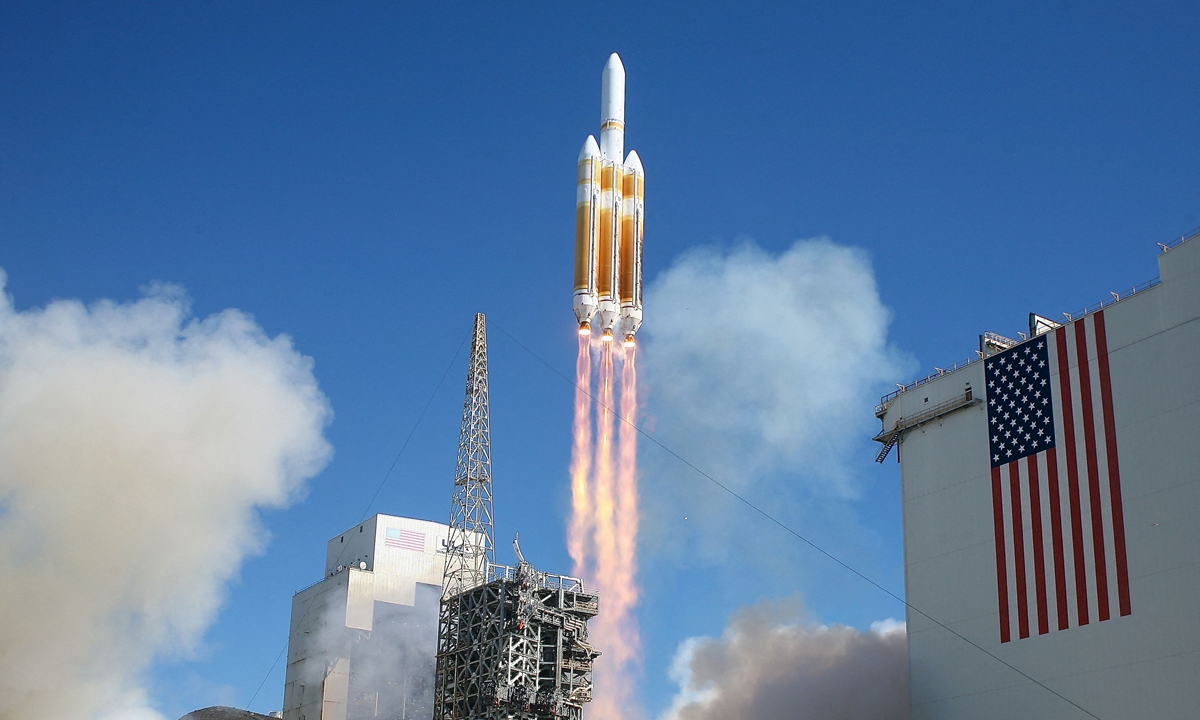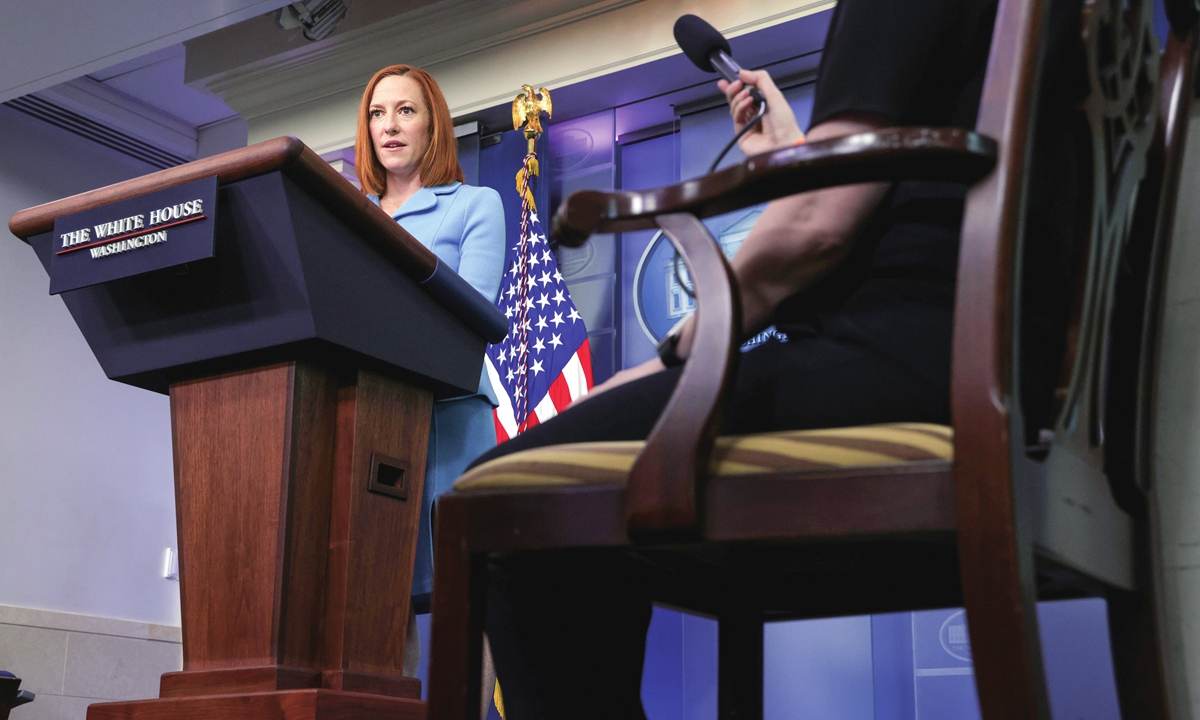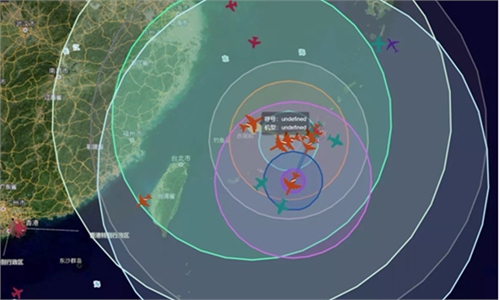Truth on US spy balloons: the US has not only numerous projects, but also a long history of spying records
By using the balloon saga, some US politicians have pushed anti-China sentiments in Washington to a climax in recent weeks so as to push the China-US relations to nadir. Aside from drumming up the rhetoric of the alleged "China threat," US officials are hyping up a more sensational accusation by claiming China has a "wider fleet" of balloons that span five continents for surveillance.
However, earlier news reports on balloons have told a different story from the US narrative - the reports showed that the US is the very country that has flown balloons all over the world with records of US balloons entering many countries' air spaces. The US also has an infamous history of using balloons for close-in reconnaissance on other countries, especially during the 1950s and 1960s, let alone its pervasive eavesdropping worldwide.
The US' abuse of military forces in shooting down the Chinese civilian airship for meteorological purposes not only violates international customs but also sets a dangerous precedent for the handling of deviated civilian balloons that have been widely used in collecting atmospheric data among other physical scientific experiments, analysts said.
The US' absurd and hysterical overreaction toward the Chinese balloon and its unceasing hyping up of spy rhetoric increased the international community's worries not only over strained China-US relations, but also over scientific research using balloons.
Senior Colonel Tan Kefei, a spokesperson with China's Ministry of National Defense, told a press conference on Thursday that "We firmly reject the irresponsible and groundless remarks made by some people in the US. The real threat to the global and regional security and stability is certain country's self-centered values and narrow-mind security value and zero-sum game mentality."
Amid the US' political stunt against the Chinese airship, the UN World Meteorological Organization (WMO) released a statement on February 17 to highlight the key role of weather balloons in climate monitoring and it said that every day, free-rising latex balloons are released simultaneously from almost 900 locations worldwide.
Nearly 1,000 balloons gather daily observations that provide real-time input. The valuable information gathered by the balloons contributes to computer forecast models, local data for meteorologists to make forecasts and predict storms, and climate monitoring and data for research to better understand weather and climate processes, said WMO.
Some innocent balloons have been blown out of the sky as one of the three balloons, which were shot down by a US fighter jet in the North American air space, reportedly belongs to a Canadian hobbyist group, leading to growing worries among scientists and researchers over the safety of civilian balloons.

Numerous balloon projects in US
The US is among the countries that have initiated programs on balloons for decades. For example, more than 30 years ago, the US National Aeronautics and Space Administration (NASA) set up the NASA Balloon Program which has "provided high-altitude scientific balloon platforms for scientific and technological investigations," according to an overview of the program on the NASA website.
Launch locations of balloons for the NASA project released on the NASA website cover the scope of North America, Europe, and the Indo-Pacific region with three in the US, one in Sweden, one in Australia, one in New Zealand and one in Antarctica. Moreover, NASA's Balloon Program Office also said it uses multiple types of balloons to "lift scientific payloads into the atmosphere," including zero-pressure, super-pressure, and planetary ballooning systems.
Aside from NASA, American companies and various organizations and clubs in the US have flown numerous balloons for commercial purposes or just as hobbies with many floating around the world.
For example, in August 2020, a large silver-colored contraption fitted with solar panels and wires was found parachuting into the dense Congo jungle, which caused public controversy and speculation surrounding the unidentified flying object and also led to the detainment of two people, according to local authorities, Reuters reported.
The subsidiary of the Google parent company Alphabet later confirmed that the balloon belonged to the Loon Project - a project that claimed to create a network of balloons traveling on the troposphere stratosphere.
As balloon activities by scientific research organizations and companies around the world become more frequent, so were cross-border flights, especially those from the US.
Zhu Yaochun, deputy secretary-general of the China Air Transport Association, told the Global Times that in international practice, civilian unmanned aircraft that accidentally enter another country's airspace should be escorted, warned, expelled, or forced to land.
Compared to previous reports on how other countries dealt with US balloons' "entry" into their airspaces, the US' shooting down of the Chinese airship using a fighter jet and missiles was a conspicuous overreaction and violation of international law and norms, observers said.
Infamous history
Although the US kept propagating the Chinese "spy balloon" narrative, it failed to provide proof to support its accusations even with the debris of the shot-down Chinese balloon having been collected and assessed.
Some analysts noted that maybe the Biden administration and the US military also find they have been lifting a stone that will end up failing on their own feet, and to appease American taxpayers, they have to continue the political balloon stunt.
While the US racks its brain in tarnishing China's image by hyping up a so-called Chinese balloon fleet, its infamous history of spying and eavesdropping worldwide has kept reverberating in history and modern times, with its spy balloon operations being traced back to the early days of the Cold War in the middle 20th century.
Historical materials show that after the WWII, the US Air Force started developing the concept of "plastic balloon reconnaissance" at around 1946 to spy on Russia, and it had test-launched over 500 reconnaissance balloons by the middle of 1954.

"On March 23, 1955, Air Force headquarters assigned the Strategic Air Command to undertake a pioneer reconnaissance of Soviet territory," read a document recalling the history of the American intelligence community between 1950 and 1955, which was published on the website of the US Office of the Historian.
The US Air Force's launching of reconnaissance balloons later evolved into the infamous Project Genetrix, also known as WS-119L. It was a program designed to launch surveillance balloons over the now defunct Soviet Union, as well as China and Eastern Europe with the help of a U-2 reconnaissance aircraft, to take aerial photographs as part of its intelligence gathering.
According to the above-mentioned document from the US Office of the Historian, this project was the codename ultimately adopted for the first US Air Force large-scale, unmanned, high-altitude balloon intelligence operation.
The WS-119L project launched a total of 516 high-altitude balloons, which provoked a serious "protest storms" among the countries involved, according to The Central Intelligence Agency and Overhead Reconnaissance 1954-1974, a secret report made public by the CIA only in 2013.
Despite strong protests by the international community, the US Air Force launched another balloon reconnaissance program in 1957, designated WS-461L. This program used an improved balloon that could allegedly float beyond the reach of Soviet air defenses.
"By employing a longer lens than the Genetrix camera, ..., high-acuity photographs could be obtained from altitudes greater than 30,000 meters," explained a CIA document "Observation balloons and reconnaissance satellites" that was approved for release on September 1999.
After the US air force put forward the notion that the near space is a new battle zone, it has done more research in vehicles flying in this zone including airships, balloons, and unmanned drones than anyone else, Huang Zhicheng, an expert on aerodynamics, told the Global Times.
Balloons have also been widely used in collecting intelligence. In 2021, the above-mentioned Loon Project was scrapped by Alphabet and Raven Aerostar, which claimed to be the world leader in high-altitude, lighter-than-air technology, acquired intellectual property and patents from Loon.
Since then, "Raven Aerostar has continued to develop its balloon technologies for other sectors, notably in the realm of intelligence and defense," The Drive, a news outlet that specializes in automotive industry and military technology news and car reviews, reported in 2021.
The Drive report also noted that Raven Aerostar's Thunderhead balloons are designed to be able to persist over an area of interest in order to carry out a wide variety of tasks. Moreover, according to the company, common applications include intelligence, surveillance, and reconnaissance (ISR) missions and act as communications relays. Additionally, the balloons can also serve in augmenting navigational systems.
Thunderhead balloons have also been used in military drills by the US. In April 2022, Army Pacific Soldiers launch a Thunderhead High-Altitude Balloon System during Balikatan 22 - the annual exercise of the Philippines and the US on Fort Magsaysay in the Philippines.
Including earlier high-altitude devices like balloons and airships, the US has used all means available for reconnaissance, said Song Zhongping, a Chinese military expert and TV commentator.
Song criticizes the US government's recent groundless accusation against China for using a "spy balloon" as being no more than a thief crying "stop thief."
In early February, local media outlets reported that the Namibian military confirmed a sail drone had been found in the waters near Lüderitz and that it was being controlled by the US.
Analysts said that the discovery of a US sail drone in Namibian territorial waters signified the increasing tendency of US spying in every corner of the world, and countries should be vigilant as US investment in intelligence globally will pose a bigger threat.
Song noted that it is such typical hegemonic and double-standard mind-set by the US that doesn't allow balloon launching by other countries while persisting in the action itself.
"The US does whatever itself believes is right, and forces the world to acquiesce all of its behaviors, even though some of the behaviors violate international laws or related conventions, and threaten the sovereignty, security, and development interests of other countries," Song said.
However, earlier news reports on balloons have told a different story from the US narrative - the reports showed that the US is the very country that has flown balloons all over the world with records of US balloons entering many countries' air spaces. The US also has an infamous history of using balloons for close-in reconnaissance on other countries, especially during the 1950s and 1960s, let alone its pervasive eavesdropping worldwide.
The US' abuse of military forces in shooting down the Chinese civilian airship for meteorological purposes not only violates international customs but also sets a dangerous precedent for the handling of deviated civilian balloons that have been widely used in collecting atmospheric data among other physical scientific experiments, analysts said.
The US' absurd and hysterical overreaction toward the Chinese balloon and its unceasing hyping up of spy rhetoric increased the international community's worries not only over strained China-US relations, but also over scientific research using balloons.
Senior Colonel Tan Kefei, a spokesperson with China's Ministry of National Defense, told a press conference on Thursday that "We firmly reject the irresponsible and groundless remarks made by some people in the US. The real threat to the global and regional security and stability is certain country's self-centered values and narrow-mind security value and zero-sum game mentality."
Amid the US' political stunt against the Chinese airship, the UN World Meteorological Organization (WMO) released a statement on February 17 to highlight the key role of weather balloons in climate monitoring and it said that every day, free-rising latex balloons are released simultaneously from almost 900 locations worldwide.
Nearly 1,000 balloons gather daily observations that provide real-time input. The valuable information gathered by the balloons contributes to computer forecast models, local data for meteorologists to make forecasts and predict storms, and climate monitoring and data for research to better understand weather and climate processes, said WMO.
Some innocent balloons have been blown out of the sky as one of the three balloons, which were shot down by a US fighter jet in the North American air space, reportedly belongs to a Canadian hobbyist group, leading to growing worries among scientists and researchers over the safety of civilian balloons.

The United Launch Alliance launches its last Delta IV heavy rocket from Vandenberg Space Force Base, California on September 24, 2022. This mission, dubbed NROL-91, lofted a top-secret spy satellite for the US National Reconnaissance Office. Photo: VCG
Numerous balloon projects in US
The US is among the countries that have initiated programs on balloons for decades. For example, more than 30 years ago, the US National Aeronautics and Space Administration (NASA) set up the NASA Balloon Program which has "provided high-altitude scientific balloon platforms for scientific and technological investigations," according to an overview of the program on the NASA website.
Launch locations of balloons for the NASA project released on the NASA website cover the scope of North America, Europe, and the Indo-Pacific region with three in the US, one in Sweden, one in Australia, one in New Zealand and one in Antarctica. Moreover, NASA's Balloon Program Office also said it uses multiple types of balloons to "lift scientific payloads into the atmosphere," including zero-pressure, super-pressure, and planetary ballooning systems.
Aside from NASA, American companies and various organizations and clubs in the US have flown numerous balloons for commercial purposes or just as hobbies with many floating around the world.
For example, in August 2020, a large silver-colored contraption fitted with solar panels and wires was found parachuting into the dense Congo jungle, which caused public controversy and speculation surrounding the unidentified flying object and also led to the detainment of two people, according to local authorities, Reuters reported.
The subsidiary of the Google parent company Alphabet later confirmed that the balloon belonged to the Loon Project - a project that claimed to create a network of balloons traveling on the troposphere stratosphere.
As balloon activities by scientific research organizations and companies around the world become more frequent, so were cross-border flights, especially those from the US.
Zhu Yaochun, deputy secretary-general of the China Air Transport Association, told the Global Times that in international practice, civilian unmanned aircraft that accidentally enter another country's airspace should be escorted, warned, expelled, or forced to land.
Compared to previous reports on how other countries dealt with US balloons' "entry" into their airspaces, the US' shooting down of the Chinese airship using a fighter jet and missiles was a conspicuous overreaction and violation of international law and norms, observers said.
Infamous history
Although the US kept propagating the Chinese "spy balloon" narrative, it failed to provide proof to support its accusations even with the debris of the shot-down Chinese balloon having been collected and assessed.
Some analysts noted that maybe the Biden administration and the US military also find they have been lifting a stone that will end up failing on their own feet, and to appease American taxpayers, they have to continue the political balloon stunt.
While the US racks its brain in tarnishing China's image by hyping up a so-called Chinese balloon fleet, its infamous history of spying and eavesdropping worldwide has kept reverberating in history and modern times, with its spy balloon operations being traced back to the early days of the Cold War in the middle 20th century.
Historical materials show that after the WWII, the US Air Force started developing the concept of "plastic balloon reconnaissance" at around 1946 to spy on Russia, and it had test-launched over 500 reconnaissance balloons by the middle of 1954.

White House Press Secretary Jen Psaki speaks during a daily press briefing on June 2, 2021 in Washington, DC, answering questions related to the Danish-US wiretapping affair. Photo: VCG
"On March 23, 1955, Air Force headquarters assigned the Strategic Air Command to undertake a pioneer reconnaissance of Soviet territory," read a document recalling the history of the American intelligence community between 1950 and 1955, which was published on the website of the US Office of the Historian.
The US Air Force's launching of reconnaissance balloons later evolved into the infamous Project Genetrix, also known as WS-119L. It was a program designed to launch surveillance balloons over the now defunct Soviet Union, as well as China and Eastern Europe with the help of a U-2 reconnaissance aircraft, to take aerial photographs as part of its intelligence gathering.
According to the above-mentioned document from the US Office of the Historian, this project was the codename ultimately adopted for the first US Air Force large-scale, unmanned, high-altitude balloon intelligence operation.
The WS-119L project launched a total of 516 high-altitude balloons, which provoked a serious "protest storms" among the countries involved, according to The Central Intelligence Agency and Overhead Reconnaissance 1954-1974, a secret report made public by the CIA only in 2013.
Despite strong protests by the international community, the US Air Force launched another balloon reconnaissance program in 1957, designated WS-461L. This program used an improved balloon that could allegedly float beyond the reach of Soviet air defenses.
"By employing a longer lens than the Genetrix camera, ..., high-acuity photographs could be obtained from altitudes greater than 30,000 meters," explained a CIA document "Observation balloons and reconnaissance satellites" that was approved for release on September 1999.
After the US air force put forward the notion that the near space is a new battle zone, it has done more research in vehicles flying in this zone including airships, balloons, and unmanned drones than anyone else, Huang Zhicheng, an expert on aerodynamics, told the Global Times.
Balloons have also been widely used in collecting intelligence. In 2021, the above-mentioned Loon Project was scrapped by Alphabet and Raven Aerostar, which claimed to be the world leader in high-altitude, lighter-than-air technology, acquired intellectual property and patents from Loon.
Since then, "Raven Aerostar has continued to develop its balloon technologies for other sectors, notably in the realm of intelligence and defense," The Drive, a news outlet that specializes in automotive industry and military technology news and car reviews, reported in 2021.
The Drive report also noted that Raven Aerostar's Thunderhead balloons are designed to be able to persist over an area of interest in order to carry out a wide variety of tasks. Moreover, according to the company, common applications include intelligence, surveillance, and reconnaissance (ISR) missions and act as communications relays. Additionally, the balloons can also serve in augmenting navigational systems.
Thunderhead balloons have also been used in military drills by the US. In April 2022, Army Pacific Soldiers launch a Thunderhead High-Altitude Balloon System during Balikatan 22 - the annual exercise of the Philippines and the US on Fort Magsaysay in the Philippines.
Including earlier high-altitude devices like balloons and airships, the US has used all means available for reconnaissance, said Song Zhongping, a Chinese military expert and TV commentator.
Song criticizes the US government's recent groundless accusation against China for using a "spy balloon" as being no more than a thief crying "stop thief."
In early February, local media outlets reported that the Namibian military confirmed a sail drone had been found in the waters near Lüderitz and that it was being controlled by the US.
Analysts said that the discovery of a US sail drone in Namibian territorial waters signified the increasing tendency of US spying in every corner of the world, and countries should be vigilant as US investment in intelligence globally will pose a bigger threat.
Song noted that it is such typical hegemonic and double-standard mind-set by the US that doesn't allow balloon launching by other countries while persisting in the action itself.
"The US does whatever itself believes is right, and forces the world to acquiesce all of its behaviors, even though some of the behaviors violate international laws or related conventions, and threaten the sovereignty, security, and development interests of other countries," Song said.



